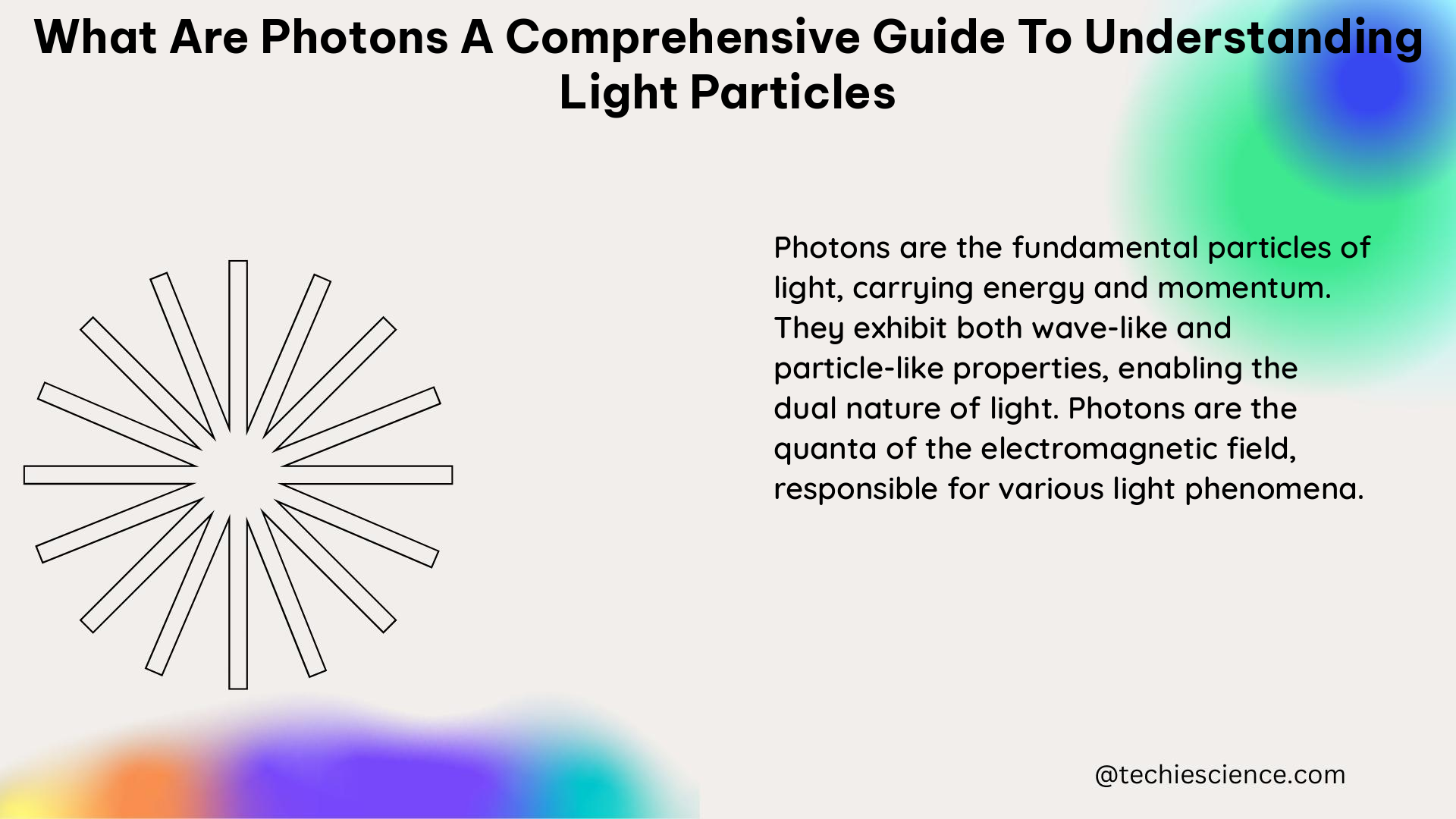Photons are the fundamental particles that make up light and other forms of electromagnetic radiation. This comprehensive guide delves into the properties, behaviors, and applications of these fascinating light particles, providing a deep understanding for physics students and enthusiasts.
Properties of Photons
Particle-Wave Duality
Photons exhibit both wave-like and particle-like properties, a central concept in quantum mechanics. This dual nature is described by the wave-particle duality, where photons can behave as both particles and waves depending on the experimental conditions.
Speed
Photons travel at the speed of light, approximately 299,792,458 meters per second in a vacuum. This speed is a fundamental constant in the universe and is denoted by the symbol c.
Massless Particles
Photons are considered massless particles, meaning they have no rest mass. However, they do carry energy and momentum, which are directly related to their frequency and wavelength.
Interactions with Other Particles
Photons can interact with other particles, particularly electrons, through various processes. One notable example is the photoelectric effect, where photons transfer their energy to electrons, causing them to be ejected from the material.
Wave-Like Behavior of Photons

Wave Function
Photons are described by a wave function, which represents the probability of finding a photon at a specific position in space. This wave function is a solution to the Schrödinger equation, a fundamental equation in quantum mechanics.
Diffraction and Interference
Photons exhibit wave-like behaviors such as diffraction and interference. When photons encounter obstacles or apertures, they can bend around the edges or interfere with each other, creating patterns that are characteristic of wave phenomena.
Particle-Like Behavior of Photons
Discrete Energy Levels
Photons have discrete energy levels, which are directly proportional to their frequency. This relationship is described by the equation E = h × ν, where E is the energy of the photon, h is Planck’s constant, and ν is the frequency of the photon.
Absorption and Emission
Photons are absorbed and emitted as discrete packets of energy, demonstrating their particle-like behavior. When an atom absorbs a photon, the energy of the photon is used to excite an electron to a higher energy level. Conversely, when an electron transitions to a lower energy level, a photon is emitted.
Quantum Mechanics and Photons
Einstein’s Photoelectric Effect
The photoelectric effect, discovered by Albert Einstein, provides evidence for the particle-like behavior of photons. In this effect, photons hitting a metal surface can eject electrons, with the energy of the ejected electrons depending on the frequency of the incident photons.
Quantum Entanglement
Photons can become entangled, where the state of one photon is correlated with the state of another, even at large distances. This phenomenon is a fundamental aspect of quantum mechanics and has important applications in quantum computing and communication.
Photons and Atoms
Interaction with Atoms
Photons interact with atoms by transferring energy to the electrons within the atom. This can cause the electrons to jump to higher energy levels or be ejected from the atom entirely, depending on the energy of the incident photon.
Photon Spin and Tumbling
Photons have a spin of 1, and they can have either a positive or negative spin as they travel. This spin, along with the photon’s tumbling motion, affects how the photon interacts with atoms and other particles.
Applications and Importance of Photons
Lighting and Vision
Photons are essential for human vision, as they carry the energy that allows us to see. The interaction of photons with the photoreceptors in our eyes enables us to perceive the world around us.
Electromagnetic Radiation
Photons make up all forms of electromagnetic radiation, including radio waves, microwaves, infrared, visible light, ultraviolet, X-rays, and gamma rays. Each type of radiation has a different frequency and wavelength, and they all play crucial roles in various applications.
Quantum Mechanics and Modern Technology
The study of photons is fundamental to understanding quantum mechanics, which has led to the development of numerous modern technologies, such as lasers, fiber optics, quantum computing, and medical imaging techniques.
Technical Specifications
Energy and Frequency
The energy of a photon is directly proportional to its frequency, as described by the equation E = h × ν, where E is the energy of the photon, h is Planck’s constant (approximately 6.626 × 10^-34 J·s), and ν is the frequency of the photon.
Wavelength and Frequency
The wavelength and frequency of a photon are related by the speed of light, as described by the equation c = λ × ν, where c is the speed of light (approximately 3 × 10^8 m/s), λ is the wavelength of the photon, and ν is the frequency of the photon.
References
- A Field Guide to Particle Physics: Episode 4 – Photons (YouTube)
- Am I Making Sense? – Color, Light & Photons Explained (Physics Forums)
- Light Particles: Duality & Quantum Physics (Vaia)
- A Curious Observer’s Guide to Quantum Mechanics, Pt. 6 (Ars Technica)
- How Photons Meet Atoms (Nouvir Lighting)
- The Feynman Lectures on Physics, Volume I (Richard Feynman)
- Quantum Mechanics (Claude Cohen-Tannoudji, Bernard Diu, Franck Laloë)
- Introduction to Quantum Mechanics (David J. Griffiths)

The lambdageeks.com Core SME Team is a group of experienced subject matter experts from diverse scientific and technical fields including Physics, Chemistry, Technology,Electronics & Electrical Engineering, Automotive, Mechanical Engineering. Our team collaborates to create high-quality, well-researched articles on a wide range of science and technology topics for the lambdageeks.com website.
All Our Senior SME are having more than 7 Years of experience in the respective fields . They are either Working Industry Professionals or assocaited With different Universities. Refer Our Authors Page to get to know About our Core SMEs.